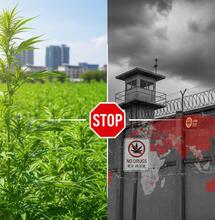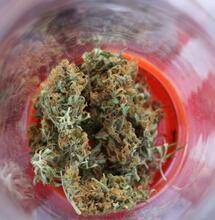New Paper Details History of Cannabis Use

We’ve known that the use of cannabis stretches back millennia. A new research paper traces the history of the "controversial plant" in greater detail. It tells us how cannabis was used as a source of fiber, tools, oils, food, medicine, as well as the paper documents spiritual and cultural practices involving the plant. Cannabis was an important asset for civilization, until it became a subject of demonization, escalating into its widespread prohibition in the early 20th-century.
A new paper, issued in the European Journal for Chemistry, explores the evidence of hemp use by ancient cultures and traces its historical path as the plant comes in touch with different peoples and territories.
The paper, titled “From ancient Asian relics to contemporaneity: A review of historical and chemical aspects of Cannabis,” is one of the more comprehensive historical and cultural accounts of cannabis use as of lately. It was penned by Brazilian researchers, Gabriel Vitor de Lima Marques and Renata Barbosa de Olivera, associated with the Federal University of Minas Gerais in Brazil.
The paper does not take a political stance on cannabis legalization. Rather, it simply takes us on an exciting journey throughout the past centuries, from the ancient days until the modern-day era. The paper documents how different cultures adopted the plant and how they used it in all kinds of social gatherings and activities, including funerals and weddings.
The First Use of Cannabis Was for Fiber
The first known uses of cannabis involved its exploitation as a material for ropes and similar manufactured goods, the authors wrote. The earliest evidence is documented in ancient Mesopotamia, approximately 10,000 years ago. Later, the same uses are seen in China and Kazakhstan, roughly 5,500 years ago.
Among the ancients, Cannabis was considered one of the five main ingredients, alongside rice, soy, barley and millet, the paper continues. Hemp was processed into fiber, and was relied upon as a durable material for rope, clothing, paper, sails and boat rigging, fishing, animal husbandry, etc. The paper goes as far as to say that “Cannabis is possibly the first plant to be cultivated for non-food purposes.”
People discovered the physiological effects of cannabis a little bit later, or around 3,000 years ago. The ancient populations who inhabited the region of India were the first to use Cannabis “as both a therapeutic and a narcotic tool” sometime around 1000 years B.C.
“The two purposes were often linked,” the authors note. “Described in the Vedas as one of the five sacred plants, it [cannabis] was believed to have arisen from a drop of amrita (sacred nectar) that fell from heaven onto the earth and was able to bring joy and freedom to those who used it,” they write.
There were three common preparations of cannabis in the Indian region. The least potent of all was in the form of bhang, a preparation of dried leaves, comparable to modern day marijuana. The unfertilized flowers where the resin accumulates were referred to as ganja and they were the second type of preparation. And the third, and the most potent one, was charas, or pure resin, the equivalent of hashish nowadays.
These preparations were used in family gatherings, including weddings, as well annual festivities, such as Holi, which celebrates the coming of the spring and the triumph of good versus evil.
The authors further note that the ancient Semitic people were also familiar with the psychoactive effect of Cannabis, centuries before the advent of Christianity. They were acquainted with both the euphoric and calming effects from using the plant.
“Its medicinal uses range from ointments for external injuries to oral preparations for various ailments and ‘sickness of the spirit’. It was common in the Mesopotamian/Persian region to use cannabis-based incense in certain social rituals, such as funerals, for example, which is even mentioned in the Aramaic version of the Old Testament of the Bible for aromatic and narcotic purposes,” the paper says.
Cannabis Traveled with Slaves to South America
Other sections of the paper sketch how cannabis journeyed between continents. For example, in South America it arrived together with African slaves from Angola. The authors trace the origins of the term “maconha,” a word adopted in the Portuguese language to refer to marijuana. The term has its roots in the native dialect of the populations that were trafficked to Brazil from Portugal.
In the rural areas of northeastern Brazil, Cannabis was widely used in cultural and magical religious rituals. Catimbó is one such festivity that celebrates the deities worshiped by the populations that came there.
In whichever place it traveled, cannabis was adopted as a healing herb. So, in South America too, it was often used as an analgesic and antispasmodic. Over the centuries, marijuana remained associated with the vulnerable ethnic racial groups inhabiting Brazil, the authors remark. The plant became known as the “opium of the poor” and the disparaging and stereotypical views around its use are still hunting Brazil to this day.
Demonization Began in the Middle Ages
It’s not like cannabis suddenly became prohibited in the 20th-century. It’s a process that started way back. One of the first institutions to besmirch the image of cannabis was the Catholic Church, which exercised tremendous powers during the medieval era.
There were times when the church was not so approving of herbal knowledge. This was the main reason why much of Europe began to hide or omit information on the therapeutic applications of Cannabis. By the 17th and 18th centuries, the medicinal use of cannabis scaled back in Europe significantly.
Later in the paper, the authors also reflect on the modern research of cannabis, highlighting the work of early scientists that looked at its chemical structure. They do make a mention of the late Raphael Mechoulam among others.
In the paper conclusion, the authors note that “Cannabis is perhaps one of the greatest controversies in contemporary humanity.” They acknowledge, despite successful efforts to decriminalize the use of Cannabis, primarily to expand its medical application, the plant still finds many obstacles on its way.
Also read on Soft Secrets:
- Who Discovered Cannabis in the First Place?








